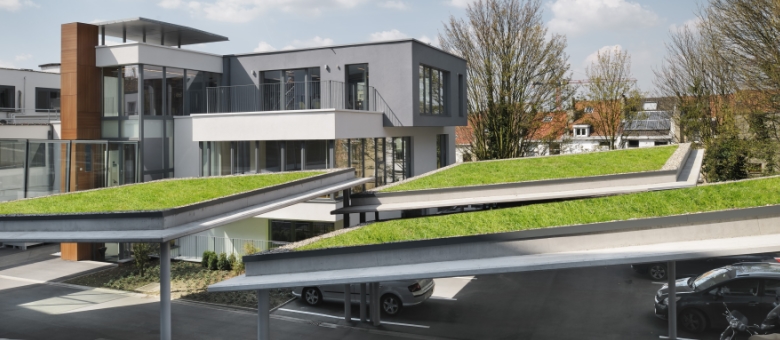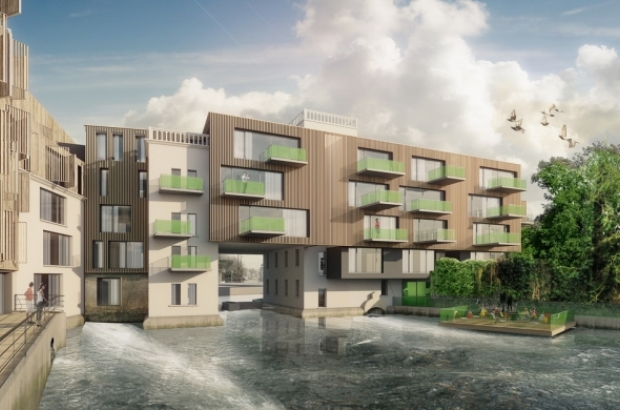- Daily & Weekly newsletters
- Buy & download The Bulletin
- Comment on our articles
Passiv-progressive: A2M architects
Just imagine: the dreaded electricity and gas bills drop through the letterbox and they come to the princely sum of… €3 a month. Sounds like a pipe-dream? Well, yes, apart from the fact that a pioneering local company is actually making this a reality for businesses and, increasingly, householders in Belgium.
Properties designed by A2M really can drastically slash the cost of heating bills. In fact, the company is designing buildings that are said to consume up to 90 percent less energy than conventionally designed properties.
And, as the company’s director Sebastian Moreno-Vacca points out, the way they do it is not rocket science. Essentially, it’s done by injecting layer upon layer of insulation – up to 30cm thick – into the walls, floors and roof of a property. Nothing in the fabric of a building is spared, from window frames to masonry.
The further use of triple as opposed to double, glazing in window frames effectively seals the property and, in doing so, minimises all unnecessary and costly heat loss. “You see,” declares Moreno-Vacca, “insulating your home is easy. Even your grandmother could do it.”
Despite his modesty, the company he leads has successfully adapted an idea originally pioneered in Germany for use in Belgium. Launched 10 years ago, A2M specialises in designing what are known as passivhaus buildings.
“These are very, very low-energy buildings,” says Moreno-Vacca. “To give you an idea, if your house, say a property of 100 square metres, is a passivhaus then we estimate your heating will cost about €3 per month. In other words, as much as a cup of coffee each month!”
At first, the concept in Belgium was mostly limited to large public buildings, such as schools and offices, but has more recently been rolled out for the design of residential properties.
In Mons, for instance, some 350 A2M-designed passivhaus homes have either been built or are under construction. In Brussels, about 100 apartments or houses have already been built to the passivhaus standard of energy reduction, while there are plans for four of the city’s kindergartens to be given the zero-emission touch. Currently, a four-star, 60-bed passivhaus hotel is being built near the Port of Brussels canal, overlooking the canal and Tour & Taxis, and other ongoing projects include social housing in Jette.
It is hoped that construction costs, which are still relatively high compared with conventionally designed buildings, will gradually come down.
As Moreno-Vacca explains, the situation is expected to drastically change in a few years when, as a result of recently enacted Belgian legislation, all newly built properties in the country will have to comply with the standard used by A2M. In Brussels, the new law comes into effect as soon as 2015, while Wallonia will be given a couple of years longer to comply.
It all means that, in effect, Belgium is attempting to go much further than is required by the European Union’s flagship ‘2020’ targets, which aim to slash energy consumption through increased energy efficiency by 20 percent by the year 2020.
Largely dismissive of the EU’s energy targets, Moreno-Vacca says, “The 20 percent target is commendable, but it simply does not go far enough. It will not have the desired impact. The passivhaus buildings we design aim to cut energy consumption by as much as 90 percent.”

Considering the potential impact of its activities, A2M is a relatively modest operation. It boasts just 10 staff, and Moreno-Vacca himself combines his role as company director with a teaching job at ULB university in Brussels, where he is a professor of architecture, a post he has held since 2007.
After graduating as an architect at ISA Saint-Luc, Moreno-Vacca launched A2M in 2000. Three years ago he started a quarterly magazine called be passive, which promotes eco-friendly ideas, and in June 2010 he had the honour of representing Belgium at the World Expo in Shanghai, where he demonstrated sustainable passivhaus projects including a school and the housing development in Mons.
The fast-growing reputation of this ‘eco-warrior’ means he is regularly invited to speak on the subject of energy efficiency in construction at seminars here and around Europe. Indeed,a Belgian newspaper recently described him as “one of a rare breed of Belgian architects”.
Four years ago, A2M created an association called Platform Passive House in Brussels and the Walloon region. The idea was to promote eco-construction through the exchange of best practice. He recalls how the company started, saying, “We embarked on our first passivhaus project quite by chance. Having won a public competition in 2002, we met an engineer who specialised in sustainable housing.
“He introduced us to the passivhaus standard and, intrigued, we visited a lot of projects and sites in Germany where the idea had already taken hold, to see how it was done.
“Mastering the basic techniques of passivhaus architecture has enabled us to focus more and more on architectural matters and issues of sustainability.
“What I have noticed is that there is now a clear trend for others in the building sector, whether they are general contracting firms or sub-contractors, to pay far more attention to – and show more interest in – the issue of energy efficiency.
“For instance, triple glazing normally costs three times the price of double glazing. This is one obvious reason why it is used so little in construction. The use of triple glazing is clearly instrumental in our work and, slowly but surely, people in the glazing sector are being won round to the potential benefits and added value of triple glazing.”
The company recently won a ‘best buildings’ competition and Brussels environment minister Evelyn Huytebroeck is among those who have lauded the efforts of A2M in reducing energy consumption. She has praised its designs for “combining energy efficiency with respect for the Art Deco heritage”.
A2M says it is particularly grateful to the Brussels Region, which has not been slow to sponsor passivhaus construction. Moreno-Vacca says, “There is, clearly, some way to go because the passivhaus concept is still at a relatively early stage. Many are still totally unaware of it.
“But,” he adds, “I really believe people are starting to wake up to what we are doing. It is truly innovative and, in no small way, is going to help tackle global warming in years to come.”
This article first appeared in WAB Magazine









